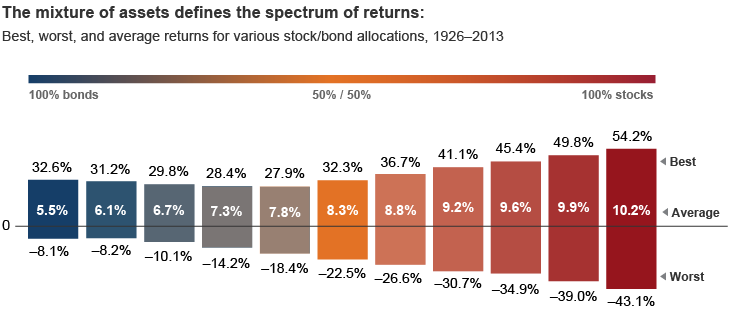Chart: What Is Risk?
From Vanguard:
I love this chart because it provides such a clear relationship between risk and return. You want more risk (say 100% stocks), well you better be prepared for great years (54.2% was the best year from 1926-2013) and be able to stomach big down years (down 43.1%) without hopping out. It also demonstrates the most important decision that an investor will make is their asset allocation or their split between stocks and bonds. Note also that stocks here doesn’t refer to picking individual stocks but rather investing in low-cost, diversified index funds and the same for bonds.
Questions for students:
- Your friend asks you “What mix of stocks and bonds will provide the highest return?” What is your answer?
- Another friends, says “I hear that you should always invest in bonds since you can’t lose money.” Is that true?
- What trend do you in terms of the range of best to worst years as you reduce the amount of stocks that you own?
- Pinpoint on the chart where you think you will be when you are ready to start investing. Why did you pick that spot?
- Which asset class, stocks or bonds, had the highest average return between 1926-2013? How much higher was its average return?
About the Author
Tim Ranzetta
Tim's saving habits started at seven when a neighbor with a broken hip gave him a dog walking job. Her recovery, which took almost a year, resulted in Tim getting to know the bank tellers quite well (and accumulating a savings account balance of over $300!). His recent entrepreneurial adventures have included driving a shredding truck, analyzing executive compensation packages for Fortune 500 companies and helping families make better college financing decisions. After volunteering in 2010 to create and teach a personal finance program at Eastside College Prep in East Palo Alto, Tim saw firsthand the impact of an engaging and activity-based curriculum, which inspired him to start a new non-profit, Next Gen Personal Finance.
SEARCH FOR CONTENT
Subscribe to the blog
Join the more than 11,000 teachers who get the NGPF daily blog delivered to their inbox:
MOST POPULAR POSTS











